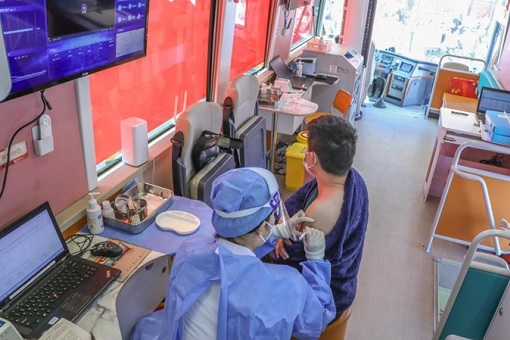China continues to do what virtually no other country in the world can. Unless you can give out 100 million shots of Covid-19 vaccine in 5 days, you can’t beat the Chinese. As of Wednesday (June 2), the country had given out 704.83 million doses. Nearly half of those jabs were administered during the month of May alone. So, what’s the big deal?
Around the world, only about 2 billion doses had been given. That means China’s 705 million doses contributed a third of the global shots. According to Our World in Data’s rolling 7-day average, China is administering about 19 million shots per day on average. At its peak, the country had broken the record by vaccinating more than 20 million people per day.
While the rollout isn’t perfect, largely due to the uneven distribution as a result of geographical factor, the Chinese government hopes to inoculate 80% of the population of 1.4 billion by the end of the year – achieving herd immunity. While some may mock or criticize the draconian system in China, it’s the same system that provides such powerful mobilization.

The Communist Party has been responsible in getting people, from the biggest city to every village to get the vaccines. Zhong Nanshan, China’s top respiratory diseases expert and the head of a group of experts attached to the National Health Commission, said that 40% of the population has received at least one dose, and the aim was to push the number to 100% by the end of the month.
In capital Beijing, 87% of the 21-million populations have received at least one dose. As early as January this year, when the China’s capital only managed to inoculate 73,000 people during the first 2 days after the vaccination program kicked off, it has already set up 220 vaccination centres around the city. Getting a shot is as easy as walking into one of those centres. But it was just the beginning.
In March, Beijing said a new way of vaccination will be introduced in April. Enter “Vaccination Bus” – the vehicle that is equipped with vaccination stations, medical refrigerators and first-aid equipment. The refrigerators are able to store 1,200 vaccine doses. The proactive move means the mobile vehicle will go to places where people need inoculation.

Once it arrives at a location, medical personnel will begin its one-stop service – registration, disinfection and vaccination. The mobile vaccine vehicle enables busy white-collar workers to receive shots from the comfort of their workplaces, saving time and improving inoculation efficiency, not to mention eliminating the potential crowds at vaccination centres.
Besides office workers, the bus can reach elderly or handicapped people easily. It’s also a convenient tool for those who do not have access to transportation. On top of its ability to vaccinate more than 150 doses in one hour, the vehicles are also equipped with onboard 5G communication system to report real-time injection data to local centres for disease control and prevention (CDC).
To accelerate vaccination, the mobile vehicles have been sent to campuses, shopping malls, construction sites and commercial areas. The developer said it could make 12 of the special-purpose vehicles per day. But the concept has just gotten better. Last month (May), Beijing announced that a new and improved mobile vaccination vehicle will go into service.

Unlike the previous mobile vaccination vehicles, the new bus-like vehicle, developed by the Chinese automaker Foton Motor Group, has an emergency bed and first-aid equipment such as oxygen cylinders and defibrillators. It is also equipped with new facilities designed to assist the elderly and handicapped people, such as a low floor near the front and a wheelchair ramp in the back.
Still, in rural areas and remote regions, people are struggling to get the Covid vaccines. Initially, there was the challenge to raise people’s awareness. Now, it’s about supply. Zhou Hongxia, a resident of Lanzhou, in northwestern Gansu province, said – “I started lining up that day at 9 in the morning, until 6 p.m., only then did I get the shot. It was exhausting. When I left, there were still people waiting.”
To make uneven distribution worse, China has to vaccinate its citizens abroad. Globally, it has vaccinated more than 500,000 overseas citizens in over 120 countries under the “Spring Sprout” program, first launched in March. For example, it has donated vaccines to Thailand, enabling Chinese nationals in the country to be inoculated. Now, its nationals in India are about to get the vaccines.

Until recently, people were not in a rush to get vaccinated in China for obvious reason. The government’s huge success in containing the pandemic had given the people a perception that the worst was over. However, with the emergence of small clusters of infections from time to time, the latest being one in the southern city of Guangzhou, there has been a sudden demand for jabs.
Sinovac and Sinopharm, the primary manufacturers of domestic vaccines being distributed in China, have both aggressively ramped up production, building brand new factories. The World Health Organization (WHO) has granted an emergency authorization for use to Sinovac’s vaccine and one of the two Sinopharm vaccines.
While Sinovac has said it has doubled its production capacity to 2 billion doses a year, Sinopharm has claimed it can make up to 3 billion doses a year. Sinovac has produced 540 million doses this year as of late May, but Sinopharm has not revealed how many doses it has produced. Nevertheless, Chinese vaccine companies enjoy a huge advantage.

Unlike what happened to the Serum Institute of India, whose production was crippled because of dependence on imports from the U.S. for certain ingredients and China for raw materials, Sinovac and Sinopharm do not rely on imported products in the manufacturing process. In the backyard of China are all the key starting materials (KSMs) and active pharmaceutical ingredients (APIs).
Other Articles That May Interest You …
- 20 Million Vaccinated Per Day – China Needed Only 5 Days To Push The Number From 500 Million To 600 Million
- China Introduces Single-Dose Vaccine – After Broke Record With More Than 15 Million People Vaccinated In A Day
- Top US Medical Adviser Fauci – India Should Learn From China How To Stop The Spreading Of Covid-19
- EU Finally Admits AstraZeneca Covid-19 Vaccine Can Cause Blood Clots – And UK Recommends Get Other Vaccines
- Sinopharm And Sinovac – Should You Trust Any Of These Chinese Covid-19 Vaccines?
- South Africa Suspends “Ineffective” Oxford-AstraZeneca Covid-19 Vaccine – Plans To Sell It And Use J&J Instead
- Forget UK’s Covid-19 Variant – This South African Coronavirus Variant Is Deadlier And Can Spread Even Faster
- Mistake Or Cheating? – AstraZeneca-Oxford Admits Manufacturing Error In Its Vaccine Effectiveness Results
- Moderna Reveals Covid Vaccine – Here’s How This 94.5% Effective Vaccine Differs From Pfizer’s Vaccine
- Coronavirus – Here’s How China Is Back To Normal While The U.S. And Europe Are Getting From Bad To Worse
- 3 Coronavirus Variants Discovered – Surprisingly, “Type-A” Found In Americans, Wuhan’s Type-B And Type-C In Europe

|
|
June 4th, 2021 by financetwitter
|


|

|

|

|

|

|




























Comments
Add your comment now.
Leave a Reply